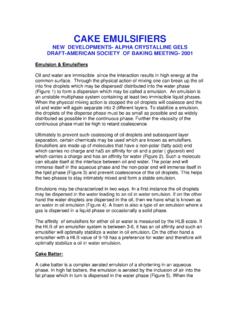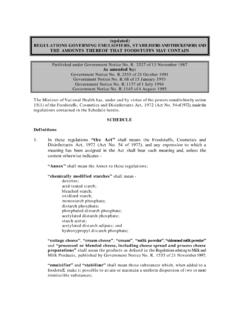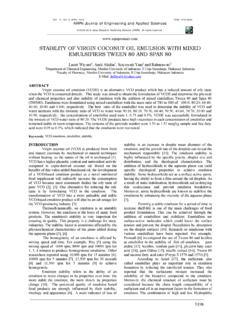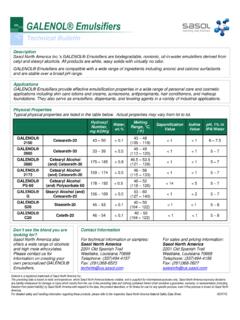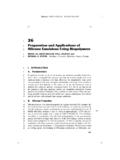Transcription of Additives for Polymer Dispersions
1 Additives for Polymer DispersionsContents 3 Technology Solutions for Polymer Dispersions 4 Antifoam Agents6 Wetting Agents10 Dispersing Agents12 Polyurethane Thickeners13 Emulsifiers3 Technology Solutions for Polymer DispersionsAqueous systems have become the preferred choice for various applications in numerous indus-tries. Dispersions require Additives and process aids during production and in their final application to provide the desired for the production of Acrylate Polyvinyl acetate (PVAc) Styrene butadiene rubber (SBR) Polyvinyl chloride (PVC) Polyurethane (PU)
2 Our product range Antifoam agents EmulsifiersAdditives for applications such as Adhesives Paper refinement Paper impregnationOur product range Antifoam agents Wetting agents Dispersing agents ThickenersOrganomodified siloxane based Additives which represent our core technology outperform conventional organic and sili-cone based products in most contrast to standard silicone oil formu-lations organomodified siloxanes combine high surface activity and efficiency with excellent compatibility in all common dis-persion systems. This opens the door to new solutions, particularly in demanding applications.
3 Organomodified siloxanes are a proven and invaluable tool in enhancing product quality and improving production brochure will give you an overview about the chemistry and the Additives that we offer for the production and application of Polymer Dispersions . We invite you to talk to our technical experts so that we can find the optimum solutions to your problem even then legislations have to be met with the additive package we are RangeTEGO AntifoamTEGO RheoTEGOPREN TEGO Surten WTEGOMER DAThickenersDispersantsWetting AgentsDefoamers4 Antifoam AgentsMagic Incredient in Polymerisation Processes and FormulationsThe carefully selected and formulated base materials provide excellent foam control and maximum compatibility at the same time.
4 The well balanced raw material base leads to a wide range of excellent defoamers, suitable for a multi-tude of industry applications. Our anti-foams do not adversely affect the perfor-mance of Dispersions and have long-term stability, providing enhanced efficiency even after storage of the formulated dis-persions. Our antifoams permit a high efficiency of production processes due to the avoidance of of the TEGO Antifoam Product Range High efficiency Attractive cost/performance ratio Superior compatibility No negative side effects Long term efficiency Good handling characteristicsTypical polymerisation, PVC and the use of antifoams TEGO Antifoam TEGO Antifoam TEGO AntifoamMonomers, water.
5 AdditivesCoolingwaterReactorBlowdownvess elStrippingcolumnSteamFiltrationHeat ExchangerStoragetankMonomerrecovery5 Test CapabilitiesDefoaming is one of the core competen-cies of the Business Unit Consumer Specialties. The laboratories are able to perform various test methods. They are designed to reflect production as well as application down test: to evaluate wetting and surface defects in film applicationMortar test: to evaluate the air content of emulsions for mortar application usedSintered glass test: to select appropriate antifoams for water-based polymerisationStirring test: to determine foam behavior in the application of Polymer Dispersions ( adhesives)6 For high performance applications ( application of pressure sensitive adhesives on siliconized papers) our wetting agents, based on organomodified siloxanes, are perfectly suited to meet demanding AgentsAdding a Droplet for Perfect SurfacesThe Gemini Technology is characterized by very efficient wetting agents, which can act as such, even at lower concentrations.
6 They can be considered as two-in-one Additives providing a combined property profile of excellent wetting behavior and good defoaming agents improve the wetting be-havior of Dispersions on substrates and diminish the defects caused by other addi-tives at the same time. Wetting agents are very efficient even at low dosage rates. In order to cover the whole range of wetting applications in the dispersion market, we offer four lines of wetting of Wetting Behavior and Decrease of Surface DefectsAlcohol alkoxylates are preferably recom-mended for highly dynamic processes. This product class is characterized by a very fast migration to the surface and by low foaming, which is beneficial for demanding applica-tions of dispersion used in quick standard applications, products based on sulfosuccinates are droplets+ Wetting agent+ Wetting agentThe improved wetting of low energy sub-strates can be guaranteed by the use of our organomodified siloxane technology which lowers the static surface formation8 With our range of wetting agents we offer solutions for different application demands.
7 Ensuring outstanding lowering surface tension for fast running processes where the dynamic surface tension has to be lowered or for very low static surfacetension to guarantee quick tests of surfactants in water show the low foaming behavior of our special wetting agents in comparison to classical sulfosuccinates. There are suitable products in our portfolio for your specific TendencyOrganomodifiedsiloxaneAlkoxylate GeminiSulfosuccinate Organomodified Siloxane Alkoxylates SulfosuccinateSurface Tension (Bubble Pressure Tensiometer)Bubble Lifetime [ms] Surfance Tension [mN/m] 2050300100050006055504540302520 StaticSubstratewettingDynamicFast process9 The influence on the water resistance of Polymer Dispersions is a critical issue oftentimes.
8 Although wetting agents are known to influence the water resistance significantly, they are indispensable in many applications. Common wetting agents like anionic surfactants, sulfosuccinates show significant influence on the water resistance, which results in reduction of adhesion power and turbid films. Due to that reason, other wetting agent technologies are needed to meet this requirement. Within our product range we offer wetting agents providing both good wetting abilities and good water resistance which can be illustrated by the good transparency of an applied adhesive film on black paper.
9 Finally la-bels may have a better adhesive strength in a humid wetting agents Organomodified siloxanes Alkoxylates Gemini surfactantStandard wetting agent SulfosuccinatesWater ResistancePerformance Benefits Sulfosuccinates are the most common wetting agents. They show good wet-ting properties, but also significant foam formation. Organomodified siloxanes are oustand-ingly lowering the surface tension of aqueous media while showing a low foam formation. Alcohol alkoxylates are very fast and low foaming wetting are recom-mended for highly dynamic processes.
10 Two-in-one Gemini Additives providing excellent wetting behavior and good defoaming are able to provide the right solution for your Surten10 Dispersing AgentsStabilizing with Know HowDispersing agents are surface-active in-gredients, which ease the incorporation of pigments and fillers into a liquid. Agglo-merates are broken up by shearing whereby new surfaces are created. They are wetted by dispersing agents which stabilize the aggregates of pigments or fillers. Dispersing agents have an amphiphilic structure which combines the following requirements: Specific anchoring groups give them the ability of being strongly absorbed onto the particle surface.

